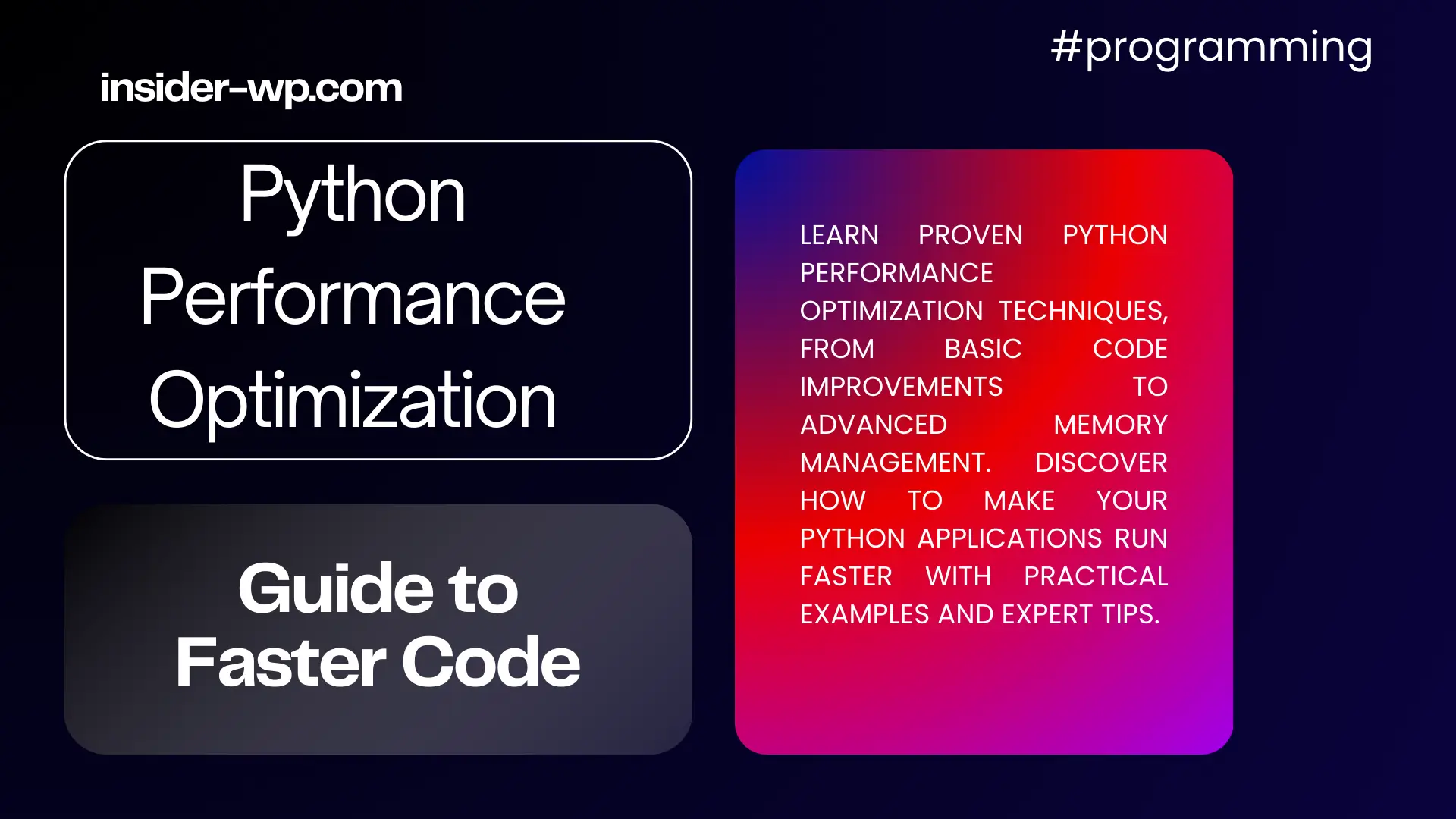Business Model Innovation Examples: Revolutionizing Industries and Driving Success

In today’s rapidly evolving business landscape, companies are constantly seeking ways to stay ahead of the competition and create lasting value for their customers. One of the most powerful tools at their disposal is business model innovation. This article will explore five inspiring business model innovation examples that have transformed industries and propelled companies to new heights of success. By examining these case studies, we’ll uncover the strategies and principles behind effective business model innovation, providing valuable insights for entrepreneurs and established businesses alike.
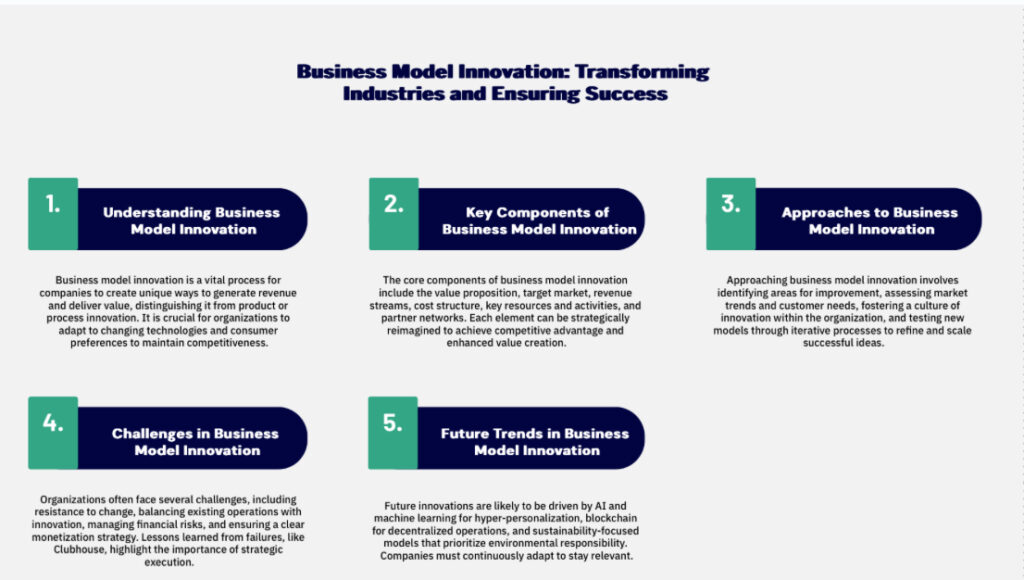
Understanding Business Model Innovation
Before diving into specific examples, it’s crucial to grasp the concept of business model innovation and its significance in today’s competitive market. Business model innovation refers to the process of creating new and unique ways to create, deliver, and capture value. Unlike product or process innovation, which focuses on improving existing offerings or internal operations, business model innovation involves fundamentally rethinking how a company operates and generates revenue.
The importance of business model innovation cannot be overstated. In an era of rapid technological advancement and shifting consumer preferences, companies that fail to adapt their business models risk becoming obsolete. Successful business model innovation can lead to:
- Enhanced value creation for customers
- Increased competitive advantage in the market
- New revenue streams and improved profitability
- Expanded market reach and customer base
- Improved resilience to industry disruptions
To illustrate the power of business model innovation, let’s consider the following diagram that shows the key components of a business model:
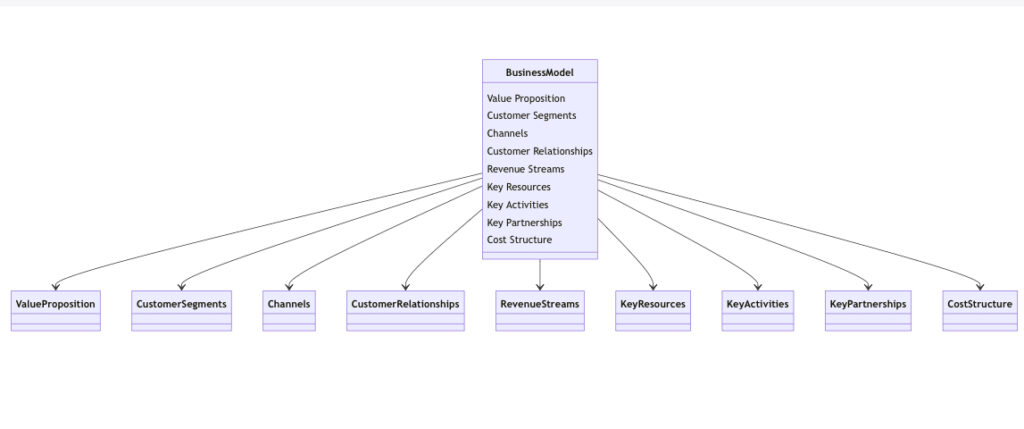
This diagram, based on the Business Model Canvas developed by Alexander Osterwalder, illustrates the interconnected elements that make up a business model. Business model innovation can involve changing one or more of these components to create a unique value proposition and competitive advantage.
Now that we have a solid understanding of business model innovation, let’s explore five inspiring examples that have reshaped industries and created significant value for both customers and companies.
Key Components of Business Model Innovation

When we’re talking about shaking things up in the business world, it’s not just about having a lightbulb moment. It’s about reimagining the whole puzzle of how your business operates. Let’s break down the key pieces of this puzzle – the components that make up a business model and are ripe for innovation.
Value Proposition: The Heart of Your Business
Your value proposition is like your business’s secret sauce. It’s what makes customers choose you over the sea of competitors out there. When you’re innovating your business model, you’ve got to ask yourself:
- What problem are we solving for our customers?
- How are we making their lives easier or better?
- What makes our solution unique or superior?
Take Netflix, for example. They didn’t just offer movies; they offered convenience, variety, and later, original content. That’s a value proposition that turned the entertainment industry on its head.
Target Market: Know Your Audience
You can’t please everyone, and you shouldn’t try to. Identifying and understanding your target market is crucial. When innovating, consider:
- Are there underserved segments in your market?
- Could you redefine your target audience?
- How might changing your audience impact other aspects of your business?
Airbnb didn’t just target travellers; they appealed to homeowners looking to make extra cash. Two birds, one innovative stone.
Revenue Streams: Show Me the Money
How you make money can be as innovative as what you’re selling. Ask yourself:
- Are there new ways to monetize your product or service?
- Could you shift from one-time purchases to recurring revenue?
- Is there potential for multiple revenue streams?
Let’s look at how different companies approach this:
| Company | Traditional Revenue Stream | Innovative Revenue Stream |
| Xerox | Selling copiers | Pay-per-copy service |
| Spotify | N/A (new entrant) | Freemium model with ads and subscriptions |
| Amazon | Online retail sales | Prime subscriptions, AWS cloud services |
Cost Structure: Efficiency is Key
Innovating your cost structure can give you a competitive edge. Consider:
- Can you leverage technology to reduce costs?
- Are there innovative ways to structure your operations?
- Could you turn fixed costs into variable costs?
Dell revolutionized computer manufacturing with its just-in-time inventory system, dramatically reducing costs and passing savings to customers.
Key Resources and Activities: Your Business Engine
These are the assets and actions that keep your business running. When innovating, think about:
- What resources are essential for your value proposition?
- Could you outsource or insource certain activities?
- Are there new technologies or methodologies you could adopt?
Consider how Amazon Web Services (AWS) turned Amazon’s internal infrastructure into a key resource and a massive revenue stream.
Partner Network: You’re Not Alone
In today’s interconnected world, who you partner with can be a game-changer. Ask yourself:
- Could strategic partnerships open new markets or capabilities?
- Are there ways to create mutually beneficial ecosystems?
- Could you turn competitors into collaborators?
Microsoft’s shift to an open app store model is a prime example of leveraging partnerships to create a more robust ecosystem.
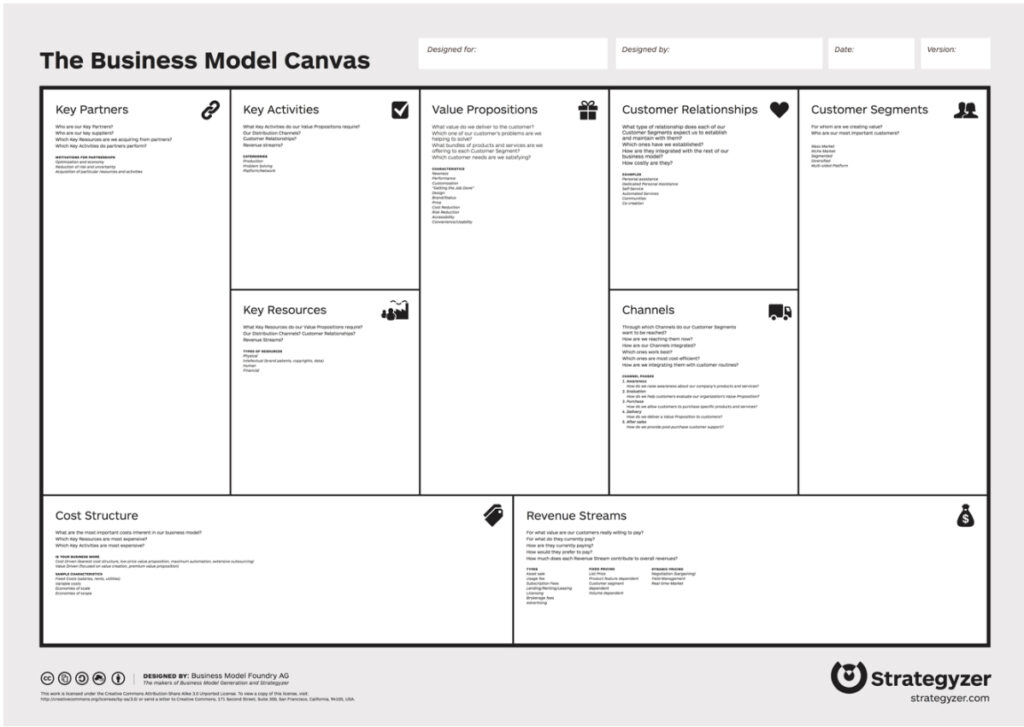
The Business Model Canvas, a tool for visualizing these components. [Source: Strategyzer.com]
Remember, true business model innovation often involves rethinking multiple components simultaneously. It’s like conducting an orchestra – when all these elements harmonize, that’s when the magic happens.
To better visualize how these game-changing innovations have evolved over time, let’s take a look at this interactive timeline of some key business model innovations:
Business Model Innovation Timeline
As you can see from this timeline, business model innovation has been a driving force in shaping our modern economy. From Alibaba’s B2B e-commerce platform in 1999 to the rise of blockchain-based currencies like Bitcoin in 2017, these innovations have continuously redefined how businesses create and deliver value to customers.
Now, let’s move on to some strategies used for business model innovation…
As you consider your own business model innovation, use these components as a checklist. Are you leveraging each one to its fullest potential? Where could a tweak or a complete overhaul create new value? The answers to these questions could be your ticket to the next big thing in your industry.
How Should You Approach Business Model Innovation?

Let’s face it: revolutionizing your business model isn’t a walk in the park. But with the right approach, you can turn your company into an innovation powerhouse. Here’s how to tackle business model innovation without losing your marbles (or your shirt).
Identifying Opportunities for Innovation
First things first: you need to spot those golden opportunities for innovation. It’s like being a detective, but instead of looking for clues to solve a crime, you’re hunting for clues to solve your business challenges.
- Analyze your value chain: Look at each step of your business process. Where are the inefficiencies? The bottlenecks? The parts that make you want to tear your hair out? These are prime candidates for innovation.
- Listen to your customers: And I mean really listen. Not just to what they’re saying, but to what they’re not saying. What are their unspoken needs? Their frustrations? Their wildest dreams? Your next big innovation might be hiding in their complaints.
- Watch your competitors: Keep an eye on what your rivals are up to. But don’t just copy them – think about how you can do it better, faster, or in a completely different way.
- Look outside your industry: Some of the best innovations come from adapting ideas from other sectors. Who’s killing it in a completely different field, and how can you apply their approach to your business?
Assessing Current Market Trends and Customer Needs
You can’t innovate in a vacuum. You need to have your finger on the pulse of what’s happening in your market and what your customers are craving.
Here’s a handy table to help you track key market trends and customer needs:
| Trend/Need | Description | Potential Impact | Opportunity for Innovation |
| Sustainability | Growing consumer demand for eco-friendly products | High | Develop circular business models |
| Personalization | Customers want tailored experiences | Medium | Implement AI-driven customization |
| Convenience | Increasing preference for on-demand services | High | Explore subscription or platform models |
| Data Privacy | Rising concerns about personal data usage | Medium | Create transparent, user-controlled data models |
Developing a Culture of Innovation Within the Organization
Innovation isn’t a one-person show – it’s a team sport. To really crush it at business model innovation, you need to get your whole organization on board.
- Encourage risk-taking: Create a safe space for your team to experiment and (gasp!) even fail. Remember, every flop is just a stepping stone to success.
- Foster diverse thinking: Bring together people from different departments, backgrounds, and viewpoints. Innovation thrives on diversity.
- Implement innovation time: Take a page from Google’s book and give your team dedicated time to work on innovative projects. You never know where the next big idea will come from.
- Recognize and reward innovation: Show your team that you value their creative efforts. Whether it’s a shout-out in the company newsletter or a hefty bonus, make sure innovation pays off.
Implementing and Testing New Business Models
Alright, you’ve got your brilliant new business model idea. Now what? It’s time to put it to the test.
- Start small: Don’t bet the farm on your new idea right away. Start with a pilot project or a limited rollout to test the waters.
- Use the Lean Startup methodology: Build a Minimum Viable Product (MVP), get it out there, and start learning from real customers ASAP.
- Measure, measure, measure: Set clear KPIs for your new model and track them religiously. Data is your best friend when it comes to validating your innovation.
- Be prepared to pivot: If something’s not working, don’t be afraid to change course. Flexibility is key in the innovation game.
- Scale gradually: Once you’ve proven your new model works, start scaling it up. But do it thoughtfully – what works on a small scale might need tweaking as you grow.
Remember, approaching business model innovation is more art than science. It requires creativity, perseverance, and a willingness to challenge the status quo. But get it right, and you could be the next big disruptor in your industry. So go on, shake things up – your future self (and your bottom line) will thank you.
Top Business Model Innovation Examples
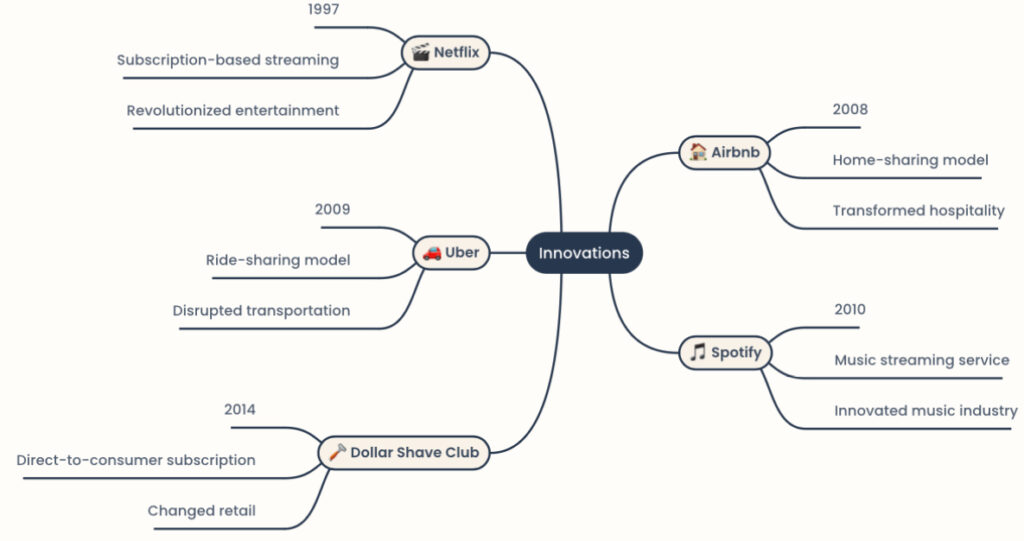
Buckle up, innovation enthusiasts! We’re about to take a whirlwind tour of some mind-blowing business model innovations. These companies didn’t just think outside the box – they crushed the box, recycled it, and built a rocket ship out of the remains. Let’s dive in!
Xerox: From Product Sales to Service-Based Model
Remember when Xerox was just about selling photocopiers? Neither do they! Xerox pulled off a business model 180 that would make even the most seasoned Silicon Valley pivot-masters jealous.
- Transition to “pay-per-copy” model: Instead of just selling machines, Xerox started charging per copy. It’s like they invented the printer equivalent of pay-per-view, but for documents!
- Impact on customer relationships and revenue streams: This shift turned one-time buyers into long-term partners. Xerox went from “Thanks for your purchase, see you in 10 years!” to “How can we help you today?”
ALD Vacuum Technologies: Innovative Service Contracts
ALD Vacuum Technologies proved that even in the world of high-tech manufacturing, there’s room for business model innovation.
- Shift from equipment sales to performance-based contracts: Instead of just selling equipment, ALD started guaranteeing performance. It’s like selling a gym membership that comes with a personal trainer and a promise to get you fit!
- Benefits for both the company and customers:
- For ALD: Steady revenue stream and deeper customer relationships
- For customers: Lower upfront costs and guaranteed performance
Netflix: Revolutionizing Entertainment Consumption
Netflix didn’t just disrupt the entertainment industry; they blew it up and rebuilt it in their image.
- Evolution from DVD rentals to streaming giant:
- Stage 1: DVD-by-mail (Bye-bye, Blockbuster!)
- Stage 2: Streaming service (Hello, binge-watching!)
- Stage 3: Original content producer (House of Cards, anyone?)
- Adaptation to changing consumer preferences and technology: Netflix didn’t just ride the wave of technological change – they surfed it like pros, always staying one step ahead of consumer demands.
Dell: Direct-to-Consumer Computer Sales
Dell looked at the computer industry and said, “You know what? We don’t need no stinkin’ middlemen!”
- Cutting out the middleman in computer sales: Dell went straight to consumers, bypassing retailers and distributors. It’s like they invented the computer industry’s version of farm-to-table!
- Customization and just-in-time manufacturing: Customers could design their perfect PC, and Dell would build it on demand. Talk about having it your way!
Dow Corning: Addressing Different Market Segments
Dow Corning showed us that you can have your cake and eat it too – or in their case, have your premium brand and your value brand too.
- Introduction of Xiameter for price-sensitive customers: Dow Corning created a separate brand for customers who wanted quality without the frills. It’s like they opened up a discount store right next to their luxury boutique!
- Maintaining premium brand while expanding market reach: This move allowed Dow Corning to tap into new markets without diluting their premium brand. Clever, right?
Subscription-based Models
Subscription models are the gift that keeps on giving – for both companies and customers!
- Amazon’s Subscribe and Save: Enhancing customer lifetime value
- How it works: Customers subscribe to regular deliveries of products they use often.
- Benefits for customers and Amazon:
- Customers: Convenience and discounts
- Amazon: Predictable revenue and increased customer loyalty
- Impact on customer retention and revenue: It’s like Amazon found the secret sauce for turning one-time buyers into lifelong fans.
- Adobe: Transitioning from one-time purchases to Software as a Service (SaaS)
- Moved from selling boxed software to cloud-based subscriptions
- Result: More stable revenue and always-updated software for customers
Platform-based Models
These companies didn’t just build businesses; they built entire ecosystems!
- Airbnb: Modularized value chain expanding market reach
- Building trust among users: Implemented review systems and insurance policies
- Expanding the total addressable market: Suddenly, every spare room became a potential hotel room
- Leveraging underutilized assets: Turned empty spaces into cash-generating machines
- Uber: Revolutionising transportation without owning vehicles
- Connected riders with drivers, disrupting the taxi industry
- Expanded into food delivery, further leveraging their platform
Open Ecosystem Models
These companies realized that sometimes, the best way to win is to let others win too!
- Microsoft’s Open App Store: Fostering an inclusive developer ecosystem
- Shift towards open marketplaces: Allowed more developers to participate and innovate
- Benefits for developers and consumers: More apps, more choices, more innovation
- Impact on industry standards: Pushed the industry towards more open, competitive practices
- Android’s open-source platform
- Allowed manufacturers to customize the OS, leading to a diverse ecosystem of devices
Other Innovative Models
Because innovation comes in all shapes and sizes!
- Freemium Models (e.g., Spotify, Dropbox)
- Offer basic services for free, charge for premium features
- Hook users with free tier, upsell to paid subscriptions
- Circular Economy Models (e.g., Patagonia, Loop)
- Focus on sustainability and reducing waste
- Patagonia’s “Don’t buy this jacket” campaign – selling less to save the planet!
- Direct-to-Consumer (D2C) Models (e.g., Dollar Shave Club, Warby Parker)
- Cut out middlemen to offer better prices and control the customer experience
- Use digital marketing to build strong brand relationships directly with consumers
There you have it, folks – a smorgasbord of business model innovations that have turned industries upside down and inside out. These companies didn’t just change the game; they rewrote the rulebook entirely. So next time you’re brainstorming ways to innovate your business, remember: sometimes the most powerful changes don’t come from what you sell, but how you sell it. Now go forth and disrupt!
Steps to Implement Business Model Innovation
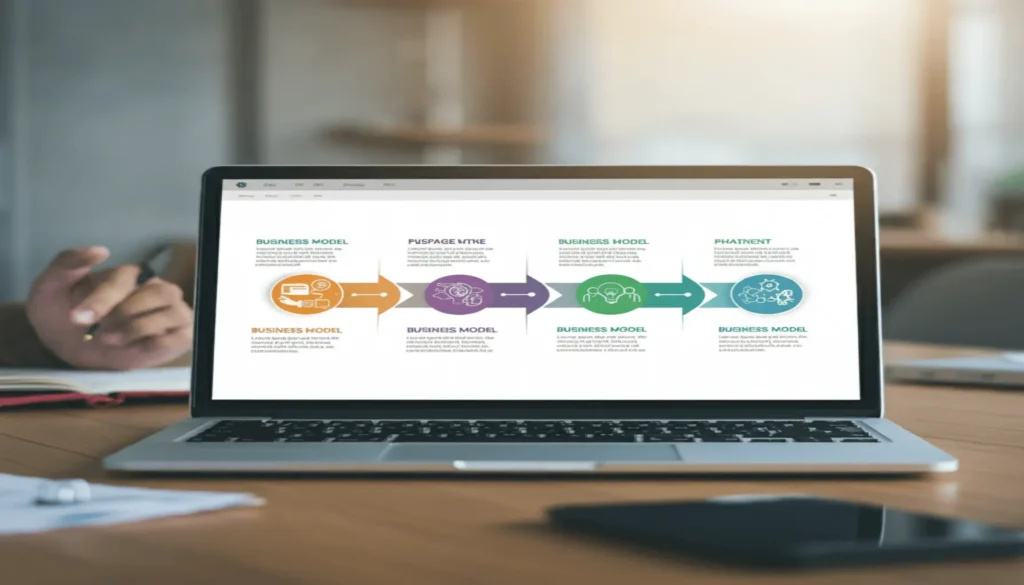
So, you’re ready to shake things up and implement some business model innovation. Buckle up, because we’re about to embark on a wild ride of creativity, strategy, and maybe just a touch of controlled chaos. Here’s your step-by-step guide to turning your business model on its head (in a good way, of course).
Identify Customer Pain Points and Unmet Needs
First things first: it’s time to channel your inner therapist and dig deep into your customers’ psyche. What keeps them up at night? What makes them want to pull their hair out? These pain points and unmet needs are your treasure map to innovation gold.
- Conduct customer interviews: Get up close and personal with your customers. Ask them about their challenges, frustrations, and secret wishes. Pro tip: sometimes what they don’t say is just as important as what they do.
- Analyze customer support data: Your support tickets are a goldmine of information. Look for common themes and recurring issues.
- Use social listening tools: Eavesdrop on social media conversations about your industry. What are people complaining about? What do they wish existed?
- Create customer journey maps: Walk a mile in your customers’ shoes. Where are the bumps in the road? The dead ends? The “I wish this was easier” moments?
Analyze Current Industry Trends and Disruptions
Now it’s time to put on your futurist hat. What’s shaking up your industry? What’s the next big thing on the horizon? Here’s how to keep your finger on the pulse:
- Follow industry thought leaders: Who are the movers and shakers in your field? Follow them on social media, read their blogs, and attend their talks.
- Attend industry conferences: Sometimes you need to get out of the office to see the big picture. Plus, the buffet lunch is usually pretty good.
- Read industry reports: Yes, they can be dry, but they’re packed with valuable insights. Think of it as eating your vegetables – good for you in the long run.
- Keep an eye on startups: What are the new kids on the block doing? They might be onto something big.
Here’s a handy table to help you track industry trends and potential disruptions:
| Trend/Disruption | Description | Potential Impact | Opportunity for Innovation |
| AI and Machine Learning | Increasing use of AI for automation and personalization | High | Develop AI-driven services or products |
| Blockchain | Decentralized, secure transaction technology | Medium | Create new trust-based business models |
| Sustainability | Growing focus on environmental impact | High | Develop circular economy initiatives |
| Remote Work | Shift towards distributed workforces | Medium | Create tools or services for remote collaboration |
Brainstorm Innovative Solutions
Alright, it’s time to let your creativity run wild. Gather your team, stock up on sticky notes and coffee, and let the ideas flow. Here are some techniques to get those creative juices flowing:
- Mind mapping: Start with your central problem and branch out with possible solutions. Don’t judge, just jot.
- SCAMPER technique: Use this acronym (Substitute, Combine, Adapt, Modify, Put to another use, Eliminate, Reverse) to spark new ideas.
- Blue Sky Thinking: Imagine you have unlimited resources. What would you do? Sometimes the most outrageous ideas lead to practical innovations.
- Reverse Brainstorming: Instead of solving the problem, think about how to make it worse. Then reverse those ideas for potential solutions.
Remember, there’s no such thing as a bad idea at this stage. Well, okay, there are bad ideas, but even they might lead to good ones. So let ’em rip!
Test and Iterate Your New Business Model
You’ve got your shiny new business model idea. Time to unleash it on the world, right? Not so fast, hotshot. Before you go all in, you need to test the waters. Here’s how:
- Create a Minimum Viable Product (MVP): Strip your idea down to its bare essentials. What’s the simplest version you can create to test your core assumptions?
- Run a pilot program: Find a small group of customers willing to try your new model. Bribe them with pizza if necessary.
- Collect feedback relentlessly: Survey your pilot customers, analyze usage data, and be open to criticism. It might sting, but it’s for your own good.
- Iterate based on feedback: Don’t be precious about your original idea. Be prepared to tweak, pivot, or even start over based on what you learn.
- Rinse and repeat: Keep testing and refining until you’ve got something that really resonates with your target market.
Scale Successful Innovations
Congratulations! Your new business model is a hit. Now it’s time to take it to the big leagues. But remember, scaling isn’t just about doing the same thing bigger – it’s about smart growth.
- Gradually increase your customer base: Don’t try to conquer the world overnight. Controlled growth allows you to manage quality and address issues as they arise.
- Invest in infrastructure: Make sure your systems can handle increased demand. Nothing kills success faster than a system crash just as you’re taking off.
- Build a scalable team: Hire people who can grow with your business. Look for adaptable problem-solvers who thrive in a changing environment.
- Keep innovating: Just because you’ve had one successful innovation doesn’t mean you can rest on your laurels. Keep pushing the envelope to stay ahead of the competition.
Remember, implementing business model innovation is a journey, not a destination. It requires persistence, flexibility, and a willingness to learn from failure. But get it right, and you could be the next big disruptor in your industry. So go forth and innovate – your future market-dominating self will thank you!
Challenges in Business Model Innovation
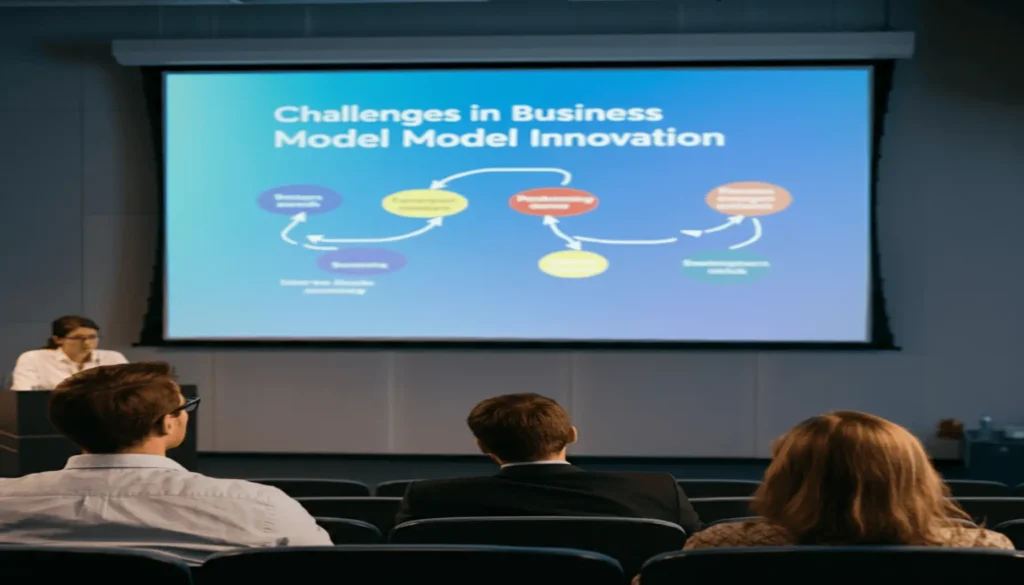
Alright, let’s get real for a minute. Business model innovation isn’t all rainbows and unicorns. It’s more like wrestling an octopus while riding a unicycle. Challenging? You bet. Impossible? Not if you’re prepared. Let’s dive into the murky waters of innovation challenges and how to navigate them without drowning.
Overcoming Organizational Resistance to Change
Ah, the classic “we’ve always done it this way” syndrome. It’s like trying to convince your gran to use TikTok – not impossible, but definitely an uphill battle.
Here’s how to tackle it:
- Communicate, communicate, communicate: Explain the ‘why’ behind the change. People are more likely to get on board if they understand the reasoning.
- Lead by example: Show your team that you’re willing to embrace change yourself. Nothing says “let’s innovate” like the CEO learning to code, right?
- Address fears head-on: Change can be scary. Acknowledge concerns and provide support to help people adapt.
- Celebrate small wins: Every step towards innovation is a victory. Make sure to recognize and reward progress.
Balancing Innovation with Existing Business Operations
It’s the classic innovator’s dilemma – how do you keep the lights on while also trying to reinvent the light bulb? Here’s a handy table to help you strike that delicate balance:
| Aspect | Existing Operations | Innovation Initiatives | Balancing Strategy |
| Resources | Require consistent allocation | Need flexible funding | Implement a dual budget system |
| Time | Focused on day-to-day tasks | Require dedicated innovation time | Use the 70-20-10 rule (70% core, 20% adjacent, 10% transformational) |
| Risk Tolerance | Generally risk-averse | Requires embracing uncertainty | Create separate ‘innovation zones’ with different risk parameters |
| Metrics | Focused on current performance | Need to measure potential and learning | Develop a balanced scorecard with both traditional and innovation metrics |
Managing Financial Risks Associated with New Models
Let’s face it, innovation isn’t cheap. It’s like remodeling your kitchen – it might look great in the end, but there’s always the risk of blowing your budget on that fancy smart fridge.
Here’s how to keep your financial ducks in a row:
- Start small: Test your new model on a small scale before going all in. It’s the business equivalent of dipping your toe in the water before diving in.
- Set clear financial boundaries: Decide upfront how much you’re willing to invest (and potentially lose) on innovation.
- Diversify your innovation portfolio: Don’t put all your eggs in one innovation basket. Spread your bets across different initiatives.
- Partner up: Share the financial burden (and the potential rewards) by collaborating with other companies or even competitors.
- Keep a close eye on metrics: Monitor your ROI religiously. Be prepared to pull the plug if things aren’t working out.
Clubhouse: A Case Study in Failed Business Model Innovation
Now, let’s learn from someone else’s mistakes, shall we? Enter Clubhouse, the audio-based social network that went from hero to zero faster than you can say “Is this thing on?”
Inability to Monetize Effectively
Clubhouse burst onto the scene with a bang, attracting millions of users… and precisely zero dollars in revenue. It’s like throwing a massive party and forgetting to charge for tickets.
Lesson learned: Have a clear monetization strategy from the get-go. Free users are great, but they don’t pay the bills.
Failure to Protect the Value Proposition
Clubhouse’s unique selling point was its audio-only, invite-only format. But they didn’t move fast enough to protect this proposition. It’s like inventing the wheel and then being surprised when everyone else starts using round things.
Lesson learned: If you’ve got a good idea, move quickly to establish and protect your unique value proposition.
Competition from Established Platforms
Before Clubhouse could say “Series A funding”, giants like Twitter and Facebook had launched their own audio features. It’s like David vs Goliath, except David forgot his slingshot.
Lesson learned: Always be prepared for competition, especially from bigger players who can quickly replicate your innovation.
The Clubhouse saga teaches us a valuable lesson: even the most hyped innovations can fall flat if you don’t address these key challenges. It’s not enough to have a cool idea – you need to be able to monetize it, protect it, and fend off the big guns.
Remember, folks: in the world of business model innovation, it’s not just about coming up with the next big thing. It’s about navigating the choppy waters of change, balancing risk and reward, and being prepared to adapt when things don’t go according to plan. Now go forth and innovate – just maybe keep one eye on your bank balance while you’re at it, eh?
Tools and Frameworks for Business Model Innovation

Alright, innovation enthusiasts, let’s dive into the toolbox of business model innovation. These aren’t your average hammer-and-nails kind of tools – think of them more like the Swiss Army knives of the business world. Each one is designed to help you slice through complexity, carve out new opportunities, and craft a business model that’s sharper than your competition’s.
Business Model Canvas
First up, we’ve got the Business Model Canvas – the granddaddy of all business model tools. Developed by Alexander Osterwalder, this bad boy helps you visualize all the building blocks of your business on one page. It’s like a snapshot of your entire business strategy, but way cooler.
Here’s a quick rundown of the nine components:
- Customer Segments: Who are you creating value for?
- Value Propositions: What pain are you solving? What gain are you creating?
- Channels: How do you reach your customers?
- Customer Relationships: What type of relationship does each customer segment expect?
- Revenue Streams: How do you make money?
- Key Resources: What do you need to make the business model work?
- Key Activities: What do you need to do to make the business model work?
- Key Partnerships: Who can help you leverage your business model?
- Cost Structure: What are the costs involved in your business model?
Pro tip: Get a big printout of this canvas, grab some sticky notes, and go to town. It’s like finger painting for grown-ups, but with the potential to revolutionize your business.
Blue Ocean Strategy
Next up, we’ve got the Blue Ocean Strategy. Developed by W. Chan Kim and Renée Mauborgne, this strategy is all about swimming away from the bloodied waters of competition (red oceans) and finding clear, uncontested market space (blue oceans).
The key here is to focus on creating new demand rather than fighting over existing customers. It’s like being the first person to sell ice cream on a hot beach – suddenly, you’ve got a line of customers who didn’t even know they wanted ice cream five minutes ago.
Here’s a nifty table to help you shift from red ocean to blue ocean thinking:
| Red Ocean Strategy | Blue Ocean Strategy |
| Compete in existing market space | Create uncontested market space |
| Beat the competition | Make the competition irrelevant |
| Exploit existing demand | Create and capture new demand |
| Make the value-cost trade-off | Break the value-cost trade-off |
| Align the whole system of a firm’s activities with its strategic choice of differentiation or low cost | Align the whole system of a firm’s activities in pursuit of differentiation and low cost |
Remember, the goal is to make your competition irrelevant, not to duke it out with them in a race to the bottom.
Design Thinking
Now, let’s talk about Design Thinking. This isn’t just for the turtleneck-wearing, latte-sipping designers out there – it’s a powerful approach to innovation that can revolutionize your business model.
The Design Thinking process typically involves five stages:
- Empathize: Get to know your users and their needs
- Define: Pinpoint the core problems you’re trying to solve
- Ideate: Brainstorm creative solutions
- Prototype: Create quick, low-fidelity versions of your ideas
- Test: Try out your prototypes and gather feedback
The beauty of Design Thinking is that it puts the user at the center of everything. It’s like being a mind reader, but instead of pulling rabbits out of hats, you’re pulling game-changing business models out of thin air.
Lean Startup Methodology
Last but not least, we’ve got the Lean Startup Methodology. Developed by Eric Ries, this approach is all about moving fast, learning faster, and not being afraid to pivot when things aren’t working.
The core of the Lean Startup method is the Build-Measure-Learn feedback loop:
- Build: Create a Minimum Viable Product (MVP)
- Measure: Collect data on how users interact with your MVP
- Learn: Use the data to decide whether to persevere or pivot
It’s like being a mad scientist, but instead of creating monsters, you’re creating business models. And instead of angry villagers with pitchforks, you’ve got customers with wallets.
Here’s a quick comparison of traditional vs. Lean Startup approaches:
| Traditional Approach | Lean Startup Approach |
| Detailed business plan | Business Model Canvas |
| Years of stealth development | Rapid prototyping and MVPs |
| Big launch | Continuous deployment |
| Measure financial metrics | Measure customer behaviors |
| Avoid failure at all costs | Embrace failure as learning |
Remember, in the Lean Startup world, failure isn’t just an option – it’s practically a rite of passage. The key is to fail fast, learn quickly, and keep iterating until you hit gold.
So there you have it, folks – your toolkit for business model innovation. Whether you’re sketching out ideas on a Business Model Canvas, exploring blue oceans, thinking like a designer, or embracing your inner lean startup guru, these tools and frameworks can help you navigate the choppy waters of innovation.
Now, go forth and innovate! And remember, if anyone tells you your ideas are crazy, just smile and say, “Thank you.” After all, they said the same thing to the person who invented the wheel, and look how that turned out.
Measuring the Success of Business Model Innovation
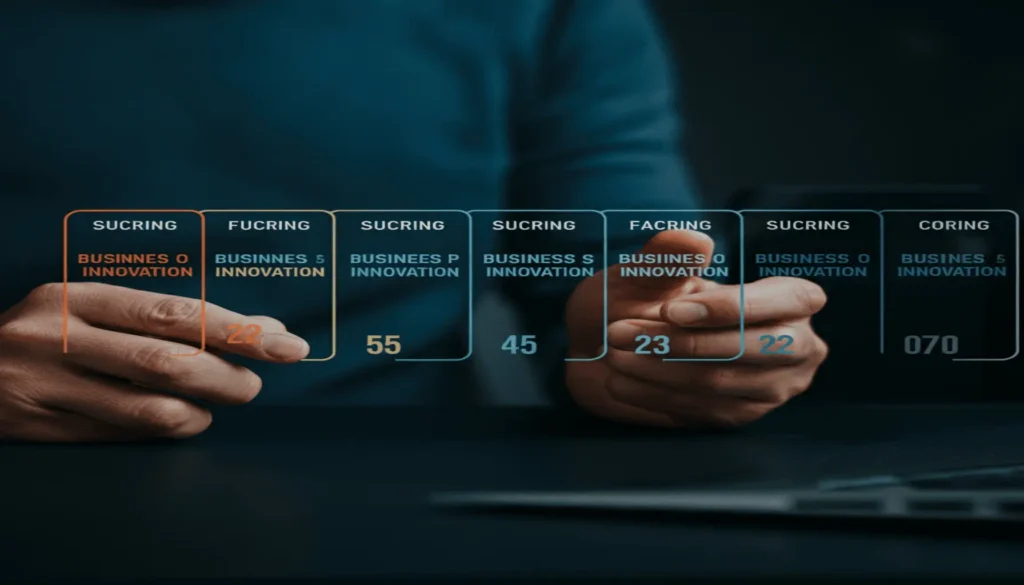
So, you’ve taken the plunge and shaken up your business model. Bravo! But now comes the million-dollar question: Is it actually working? Let’s dive into how to measure the success of your business model innovation without drowning in a sea of metrics.
Key Performance Indicators (KPIs) to Track
First things first: you need to know what to measure. Here’s a list of KPIs that’ll help you separate the wheat from the chaff when it comes to your business model innovation:
- Customer Acquisition Cost (CAC): How much dough are you shelling out to bring new customers on board?
- Customer Lifetime Value (CLV): What’s the long-term value of each customer you’ve wooed?
- Revenue Growth Rate: Is your top line shooting for the stars or stuck in the mud?
- Profit Margin: Are you actually making more money, or just spinning your wheels faster?
- Customer Retention Rate: Are your customers sticking around, or heading for the hills?
- Market Share: Are you eating your competitors’ lunch, or are they munching on yours?
- Net Promoter Score (NPS): Would your customers recommend you, or recommend running away from you?
- Time to Market: How quickly can you turn ideas into reality?
- Employee Satisfaction: Are your people jazzed about the new direction, or polishing their resumes?
- Sustainability Metrics: Is your new model helping you save the planet while saving your bottom line?
Here’s a handy-dandy table to help you track these KPIs:
| KPI | Formula | Target | Current | Status |
| CAC | Total Sales & Marketing Cost / # New Customers | $100 | $120 | 🔴 |
| CLV | Avg. Purchase Value * Avg. # of Purchases * Avg. Customer Lifespan | $1000 | $950 | 🟡 |
| Revenue Growth Rate | (Current Revenue – Previous Revenue) / Previous Revenue * 100 | 20% | 25% | 🟢 |
| Profit Margin | (Revenue – Costs) / Revenue * 100 | 15% | 17% | 🟢 |
| Customer Retention Rate | (# Customers at End – # New Customers) / # Customers at Start * 100 | 85% | 82% | 🟡 |
Long-term vs. Short-term Impact Assessment
Now, let’s talk about playing the long game versus scoring quick wins. Assessing the impact of your business model innovation isn’t a sprint; it’s more like a marathon… with hurdles… uphill… both ways.
Short-term Impact:
- Quick revenue boosts
- Immediate cost savings
- Initial customer feedback
- Early adoption rates
Long-term Impact:
- Sustained market position
- Brand equity growth
- Ecosystem development
- Industry influence
Here’s the kicker: you need to balance both. It’s like juggling flaming torches while riding a unicycle – tricky, but impressive when you pull it off.
Case Studies of Successful Business Model Innovations
Nothing beats learning from the best. Let’s take a quick tour of some business model innovations that hit it out of the park, and peek at their success metrics.
Case Study 1: Netflix
- Innovation: Shift from DVD rentals to streaming
- Key Metrics:
- Subscriber Growth: From 7.48 million in 2007 to 231 million in 2022
- Revenue: From $1.2 billion in 2007 to $29.7 billion in 2022
- Market Cap: From $1.4 billion in 2007 to $161 billion in 2023
Case Study 2: Adobe
- Innovation: Transition to Software as a Service (SaaS) model
- Key Metrics:
- Recurring Revenue: From 19% in 2011 to 89% in 2021
- Revenue: From $4.2 billion in 2011 to $15.8 billion in 2021
- Stock Price: From $28 in 2011 to $575 in 2021 (adjusted for splits)
Case Study 3: Airbnb
- Innovation: Peer-to-peer lodging platform
- Key Metrics:
- Listings Growth: From 50,000 in 2011 to 6.6 million in 2023
- Revenue: From $7.8 million in 2011 to $8.4 billion in 2022
- Valuation: From $1 billion in 2011 to $85 billion in 2023
The takeaway? Successful business model innovations don’t just move the needle – they redraw the entire dial. They transform industries, redefine value propositions, and create entirely new markets.
Remember, measuring the success of your business model innovation isn’t just about crunching numbers (though there’s plenty of that). It’s about telling the story of your transformation, backed by cold, hard data. It’s about proving that your bold move wasn’t just a shot in the dark, but a calculated leap into a brighter future.
So, go forth and measure! Your metrics are the breadcrumbs that’ll show you (and your stakeholders) that you’re on the right path to innovation greatness. And who knows? Maybe your business will be the next case study we’re all studying with awe and envy.
Future Trends in Business Model Innovation

Alright, future-gazers and crystal ball enthusiasts, it’s time to don our innovation goggles and peer into the misty realm of what’s next in business model innovation. Buckle up, because the future is looking wilder than a roller coaster designed by Salvador Dali!
AI and Machine Learning-Driven Models
Remember when AI was just a twinkle in a sci-fi writer’s eye? Well, those days are long gone. AI and machine learning are now the cool kids on the business block, and they’re reshaping business models faster than you can say “artificial intelligence.”
Here’s how AI is set to rock the business world:
Hyper-Personalization
Imagine a world where every customer interaction is as tailored as a bespoke suit. AI-driven models will create unique experiences for each customer, predicting their needs before they even know they have them. It’s like having a psychic barista who starts making your coffee before you’ve even decided you want one!
Autonomous Operations
We’re talking businesses that practically run themselves. AI will optimize supply chains, manage inventory, and even handle customer service. Human employees? They’ll be freed up to do what they do best: creative thinking and strategic decision-making (and maybe the occasional coffee run).
Predictive Analytics on Steroids
Future AI models will forecast market trends, customer behaviors, and potential disruptions with scary accuracy. It’s like having a business crystal ball, minus the mystical hand-waving.
Blockchain and Decentralised Business Models
Blockchain isn’t just for crypto bros anymore. This tech is set to disrupt traditional business models and usher in a new era of decentralization. Here’s what’s cooking in the blockchain kitchen:
Decentralized Autonomous Organizations (DAOs)
Imagine a company with no CEO, no board of directors, and no middle management. Just a set of rules encoded on the blockchain and a community of stakeholders making decisions. It’s like a corporate anarchy, but with better record-keeping!
Tokenization of Everything
From real estate to art to your grandma’s secret recipe, anything of value could be tokenized and traded on the blockchain. It’s fractional ownership on steroids.
Trust-as-a-Service
With blockchain’s immutable ledger, businesses can offer unprecedented levels of transparency and trust. It’s like having a lie detector built into every transaction.
Micro-transactions and Nano-payments
Blockchain could make it economically viable to charge for the tiniest services. Read an article? That’ll be 0.0001 cents, please!
Here’s a quick comparison of traditional vs. blockchain-based business models:
| Aspect | Traditional Model | Blockchain-Based Model |
| Governance | Centralized | Decentralized |
| Transparency | Limited | High |
| Intermediaries | Many | Few or None |
| Transaction Speed | Varies | Generally Faster |
| Cost Structure | Often High | Potentially Lower |
| Trust Mechanism | Third-party Validation | Cryptographic Proof |
Sustainability-Focused Innovations
If there’s one trend that’s hotter than a summer sidewalk, it’s sustainability. The businesses of tomorrow won’t just be green; they’ll be downright chlorophyll-tastic!
Here’s how sustainability is reshaping business models:
Circular Economy Models
Say goodbye to the old “take-make-waste” linear economy. The future is circular, baby! Products will be designed for reuse, repair, and recycling. It’s like playing economic hot potato, but with less waste and more saving the planet.
Carbon-Negative Business Models
Companies won’t just aim for net-zero emissions; they’ll actively remove carbon from the atmosphere. Imagine a world where the more successful a business is, the cleaner the air gets. It’s like reverse pollution!
Nature-Based Solutions
Businesses will increasingly look to nature for inspiration and solutions. Biomimicry will drive innovation in everything from product design to organizational structures. Who knew that slime mold could teach us about efficient supply chain management?
Regenerative Business Models
These go beyond sustainability to actually improve the environment. Think farms that enrich the soil, buildings that clean the air, and factories that purify water. It’s like a corporate version of Captain Planet!
The future of business model innovation is a wild cocktail of AI smarts, blockchain rebellion, and eco-warrior spirit. It’s a world where businesses don’t just adapt to change – they drive it, shape it, and surf its waves like digital-age Kelly Slaters.
So, whether you’re a startup maverick or a corporate bigwig, it’s time to embrace these trends and start innovating. Because in the business world of tomorrow, the only constant will be change – and the only successful strategy will be continuous innovation.
Remember, folks: the future belongs to those who innovate today. So go forth and disrupt, before you get disrupted!
Conclusion: Innovate or Evaporate – Your Business Model’s Future Depends On It
Well, folks, we’ve been on quite the journey through the wild and wonderful world of business model innovation. Let’s take a moment to catch our breath and reflect on what we’ve learned. (Don’t worry, I promise this won’t feel like a boring recap at the end of a TV show.)
The Greatest Hits: Our Business Model Innovation All-Stars
We’ve seen some pretty impressive examples of companies that didn’t just think outside the box – they basically dropkicked the box into another dimension. Let’s give a quick round of applause to our innovation superstars:
- Xerox: Turned copying from a product into a service. Genius!
- Netflix: Went from mailing DVDs to streaming entertainment directly into our eyeballs.
- Airbnb: Became the world’s largest accommodation provider without owning a single hotel. Talk about a plot twist!
- Amazon’s Subscribe and Save: Made running out of toilet paper a thing of the past.
- Microsoft’s Open App Store: Showed that even tech giants can play nice with others.
Why Keep Innovating? Because Standing Still is the New Moving Backwards
In today’s fast-paced business world, resting on your laurels is about as effective as trying to win a Formula 1 race in a horse-drawn carriage. Here’s why continuous innovation isn’t just nice to have – it’s as essential as your morning coffee:
- Stay Ahead of the Competition: While you’re patting yourself on the back for last year’s brilliant idea, your competitors are working on the next big thing.
- Meet Evolving Customer Needs: Customer preferences change faster than fashion trends. Keep up, or become the business equivalent of parachute pants.
- Adapt to Technological Changes: Remember Blockbuster? No? Exactly. Don’t be a Blockbuster in a Netflix world.
- Improve Efficiency: Innovation isn’t just about new products – it’s about finding smarter ways to work.
- Attract Top Talent: Innovative companies are talent magnets. Be the Google, not the “where are they now?” company.
Your Turn: Unleash Your Inner Innovation Superhero
Now that we’ve filled your brain with inspiring examples and sage advice, it’s time for you to don your innovation cape and take flight. Here are some parting thoughts to fuel your journey:
- Start Small, Dream Big: You don’t need to revolutionize your entire industry overnight. Begin with small experiments and scale what works.
- Embrace Failure: Remember, even Thomas Edison had to go through 1,000 unsuccessful attempts before inventing the light bulb. Imagine if he’d given up at 999!
- Listen to the Crazy Ideas: Sometimes the ideas that sound the most bonkers turn out to be pure genius. Give them a chance.
- Collaborate and Co-create: Innovation doesn’t happen in a vacuum. Bring in diverse perspectives, partner with other organizations, and co-create with your customers.
- Never Stop Learning: Stay curious, keep exploring, and always be on the lookout for new ideas and inspiration.
Remember, every business empire started with a single innovative idea. Who knows? Your groundbreaking business model innovation could be just around the corner. So go forth, innovate, and may the forces of creativity and market disruption be with you!
And hey, when you do come up with the next world-changing business model, don’t forget to send us a fruit basket or something. We’ll be here, cheering you on and probably writing another article about your brilliant success. Now get out there and innovate!
FAQs About Business Model Innovation Examples
Got questions about business model innovation? We’ve got answers! Buckle up for a wild ride through the world of game-changing business ideas.
What is an example of business model innovation?
Picture this: You’re Netflix in the late 90s, mailing DVDs to movie buffs. Then suddenly, you think, “Hey, what if we just… streamed everything?” Boom! That’s business model innovation, folks. Netflix went from a rental service to a streaming giant, changing how we consume entertainment forever.
What is an example of innovation in business?
Innovation in business is like adding sparkles to your unicorn – it makes everything more magical. Take Spotify, for instance. They looked at the music industry and said, “What if we let people listen to ALL the songs for a flat monthly fee?” That’s innovation with a capital “I”!
Is Uber an example of business model innovation?
Is the Pope Catholic? Does a bear… well, you get the idea. Uber is practically the poster child for business model innovation. They turned the taxi industry on its head by connecting riders directly with drivers through an app. No dispatchers, no yellow cabs, just tap-and-ride convenience.
What are some examples of business models?
Business models are like flavors of ice cream – there’s something for everyone. Here’s a taste:
- Subscription (Netflix, Spotify)
- Freemium (Dropbox, LinkedIn)
- Marketplace (Amazon, eBay)
- Razor and blade (Gillette, printer companies)
- Franchise (McDonald’s, Subway)
What are innovative business models?
Innovative business models are the cool kids of the business world. They break rules, challenge norms, and make everyone go “Wow!” Some examples:
- Circular economy models (Patagonia’s Worn Wear)
- Platform models (Airbnb, Uber)
- Subscription boxes (Dollar Shave Club, Blue Apron)
- Pay-what-you-want (Humble Bundle)
- Decentralized models (blockchain-based businesses)
How can business model innovation increase customer value?
Business model innovation is like a customer value multiplier. It can:
- Lower prices (think Walmart’s efficient supply chain)
- Increase convenience (Amazon’s one-click ordering)
- Provide new solutions (Zipcar’s car-sharing model)
- Offer personalization (Netflix’s recommendation algorithm)
- Create community (Peloton’s social fitness platform)
What are the top business model innovation examples?
Picking the “top” business model innovations is like choosing your favorite child – it’s tough and someone’s feelings might get hurt. But here are some game-changers:
- Apple’s iTunes + iPod ecosystem
- Amazon’s e-commerce + AWS combo
- Google’s search + advertising model
- Airbnb’s peer-to-peer lodging platform
- Tesla’s direct-to-consumer electric vehicles
What strategies are used for business model innovation?
Innovating your business model isn’t about throwing spaghetti at the wall (though that can be fun). Here are some tried-and-true strategies:
- Value chain reconfiguration
- New revenue models
- Target market expansion
- Digitalization of products/services
- Ecosystem creation
Can you give examples of successful business model innovations?
Successful business model innovations are like unicorns – rare and magical. Here are a few that hit the jackpot :
- Dollar Shave Club: Subscription razors delivered to your door
- Rent the Runway: Designer dress rentals for the masses
- Nespresso: Premium coffee pods with proprietary machines
- Rolls-Royce: “Power by the Hour” jet engine leasing
- Spotify: Streaming music with a freemium model
What are the benefits of business model innovation?
Business model innovation is like a superpower for your company. Benefits include:
- Increased revenue and profitability
- Improved customer loyalty
- Enhanced competitive advantage
- Access to new markets
- Greater resilience to market changes
What is the most successful business model innovation example?
Asking for the “most successful” business model innovation is like asking for the best pizza topping – it’s subjective and bound to start arguments. But if we had to pick one that changed the game, it might be Amazon. They started as an online bookstore and evolved into an e-commerce giant, cloud services provider, and much more. Their innovation never stops!
How often should a company consider business model innovation?
There’s no one-size-fits-all answer, but think of it like dental check-ups – regular reviews are essential for health. At minimum, companies should reassess their business model:
- Annually during strategic planning
- When facing significant market changes
- If experiencing declining performance
- When new technologies emerge in their industry
Can small businesses benefit from business model innovation?
Can a penguin benefit from a swimsuit? Absolutely! Small businesses can use business model innovation to:
- Differentiate from larger competitors
- Adapt quickly to market changes
- Maximize limited resources
- Create unique value propositions
- Punch above their weight in the market
What are the risks associated with business model innovation?
Innovation isn’t all rainbows and unicorns. Risks include:
- Financial investment without guaranteed returns
- Potential alienation of existing customers
- Operational disruption during transition
- Resistance from employees or partners
- Regulatory challenges in new business areas
How does digital transformation relate to business model innovation?
Digital transformation and business model innovation are like peanut butter and jelly – they’re great on their own, but magic together. Digital transformation often enables new business models by:
- Creating new channels to reach customers
- Enabling data-driven decision making
- Automating processes for efficiency
- Facilitating new types of products or services
- Allowing for more personalized customer experiences
What made Amazon’s Subscribe and Save program so successful?
Amazon’s Subscribe and Save is like the gift that keeps on giving – for both customers and Amazon. Its success factors include:
- Convenience for customers (no more running out of essentials)
- Predictable revenue for Amazon
- Increased customer loyalty and lifetime value
- Bulk purchasing power, leading to better margins
- Data collection for improved product recommendations
How did Airbnb’s business model innovation expand its market reach?
Airbnb’s innovation was like putting the hospitality industry in a blender. They expanded their market reach by:
- Tapping into unused private living spaces
- Offering unique, local experiences
- Providing more affordable options than traditional hotels
- Expanding into new categories (Experiences, Luxe)
- Creating a trusted platform for peer-to-peer transactions
What is the significance of Microsoft’s open app store initiative?
Microsoft’s open app store is like throwing a party and inviting everyone – even your competitors. Its significance lies in:
- Fostering a more inclusive developer ecosystem
- Challenging the status quo of app store monopolies
- Potentially reducing costs for developers and consumers
- Encouraging innovation through increased competition
- Adapting to regulatory pressures and market demands
Why did Clubhouse’s business model fail to sustain its initial success?
Clubhouse’s story is like a shooting star – bright but short-lived. Factors contributing to its decline include:
- Lack of a clear monetization strategy
- Failure to protect its unique value proposition
- Competition from established platforms (Twitter Spaces, Facebook Live Audio Rooms)
- Declining user interest as pandemic restrictions eased
- Challenges in content moderation and user retention
How can a company determine if it needs business model innovation?
Knowing when you need business model innovation is like recognizing when you need a haircut – sometimes it’s obvious, sometimes you need a friend to tell you. Here are some signs:
- Declining revenue or market share
- Emerging technologies disrupting your industry
- Changes in customer behavior or preferences
- New regulations impacting your current model
- Difficulty scaling or expanding into new markets
Remember, in the world of business, standing still is like moving backward. Keep innovating, keep growing, and who knows? Your business might be the next case study in business model innovation!

